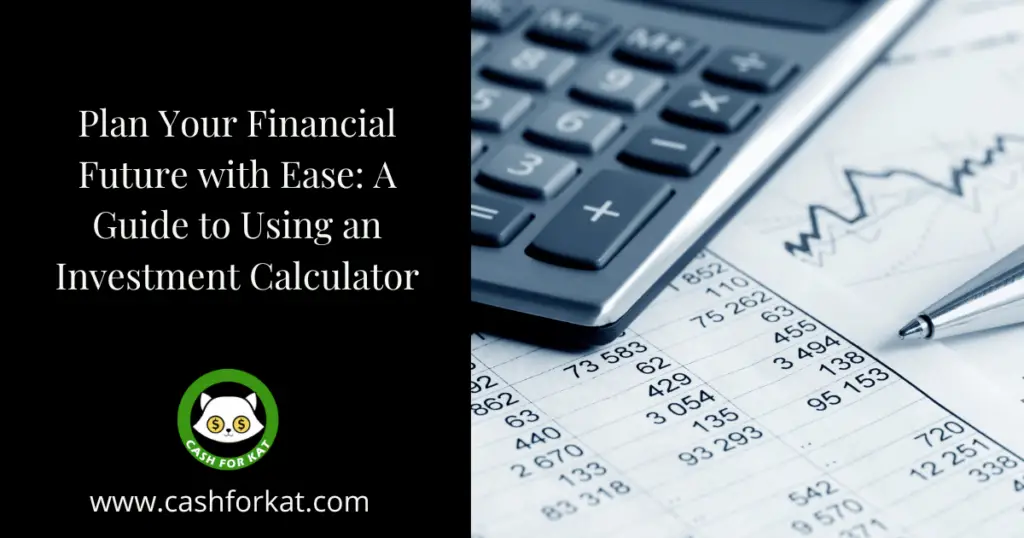
Financial planning might sound intimidating, but it doesn’t have to be. Whether you’re dreaming about a comfortable retirement, saving for your child’s education, or building long-term wealth, a well-informed plan can make all the difference. This is where an investment calculator steps in. These simple yet powerful tools can help you visualize your financial future and make smarter decisions along the way.
In this article, I’ll break down what an investment calculator is, guide you through its features, and show you how to harness its full potential to meet your goals. By the end, you’ll be equipped with the knowledge to confidently plan and track your financial investments.
Table of Contents
- What Is an Investment Calculator?
- How to Use an Investment Calculator?
- Types of Investment Calculators
- Benefits of Using Investment Calculators
- Start Securing Your Financial Future Today
What Is an Investment Calculator?
An investment calculator is a digital tool that helps estimate the growth of an investment based on key factors like initial investment, return rate, contribution frequency, and risk tolerance. It enables users to make informed financial decisions by visualizing potential outcomes.
Unlike a conventional calculator that has basic mathematical functions, an investment calculator can compute formulas that determine how much your investment will grow over time.
Whether planning for retirement or wealth accumulation, an investment calculator provides a clear projection of future returns, making financial planning easier.
Remember: the earlier you start investing, the earlier you can retire.
How to Use an Investment Calculator?
Using an investment calculator is straightforward. You simply input relevant financial data, such as the amount you are investing, how often you will make additional contributions, the duration of the investment, and your expected return rate.
There are five values that make up a financial calculator. You will typically need four of those numbers and the fifth serves as your result. Now, don’t worry if you’re not good at math because this makes a lot more sense when you input the information. In the meantime, let’s go over each of those variables.
- Final amount: The projected total amount at the end of the investment period. This will be the result if you are calculating how much you will have saved at retirement age.
- Number of periods: This is the number of times that interest compounds in a year.
- Interest rate: The expected rate of return on your investment as a percentage (example: 5%).
- Initial Amount: The amount of money that you will start your investment with. This can be 0 if you are just starting.
- Time: The number of years that you will invest for.
Most investment calculators offer the flexibility to solve for a selected variable, so you could also calculate the monthly payment needed to reach your retirement goal, or even determine how much you should invest at the start.
Step-By-Step Guide to Using Investment Calculator
Here is a detailed step-by-step guide to using an investment calculator to accurately calculate your investment returns and plan your financial future:
- Choose the right investment calculator: Select an investment calculator suited to your investment type and input your initial investment and any planned contributions (monthly or annual).
- Input expected return rate: Use historical performance or fixed returns to determine the expected return rate. Some investors may target 10% to 12%, while others may opt for lower fixed returns.
- Set investment duration: Input how long you plan to hold the investment (in years).
- Include current investments: Add details of any existing investments, if applicable.
Once all data is entered, the calculator will estimate the future value of your investment, helping you make informed financial decisions. Be it for education or retirement, this tool allows you to invest the right amount and fulfill your investment plans.
Types of Investment Calculators
Investment calculators come in various types, each designed to serve a specific purpose and applications in helping you manage and grow your finances. Here are three common types of investment calculators:
Compound Interest Calculator:
A compound interest calculator helps investors estimate how their investments will grow over time by factoring in both the initial principal and the accumulated interest. This is known as the “Power of Compounding”, where your money grows exponentially as interest is added to the principal, and that interest itself earns more interest over time.
The compound interest formula is:
A = P(1 + r/n)(nt)
Where:
- A = Future investment value
- P = Initial principal amount
- r = Annual interest rate (decimal)
- n = Compounding frequency per year
- t = Investment duration (years)
Example: Let’s say you invest $10,000 at an annual interest rate of 8%. Here’s how the investment grows over different periods, assuming the interest is compounded annually (n=1):
| Number of Years | Principal amount ($) | Interest earned ($) | Total investment value($) |
| 1 | 10000 | 800 | 10800 |
| 5 | 10000 | 4693.28 | 14693.28 |
| 10 | 10000 | 11589.25 | 21589.25 |
| 20 | 10000 | 36609.57 | 46609.57 |
| 30 | 10000 | 90626.57 | 100626.57 |
Key Takeaway: As seen in the table, the total value of your investment grows exponentially over time. By the end of 30 years, your initial $10,000 investment grows to $100,627, demonstrating the powerful effect of compound interest. The longer you stay invested, the more your money compounds, leading to significant growth.
Compound Interest Calculator
Future Investment Value (A):
Principal (P):
Interest Earned:
Recurring Investment Calculator
Most investors do not make a one-time investment and instead contribute monthly. A recurring investment calculator is an effective way for investors to invest a fixed amount regularly over a specified period. The recurring investment calculator allows you to estimate the future value of your investments based on your chosen amount, investment frequency, duration, and expected returns.
Once you input the relevant details, the calculator will estimate the future value of your investment, or the maturity value, which is the total accumulated value of your investment after the chosen duration. This includes the principal invested as well as the compounded returns.
The recurring investment formula is similar to the one used for compounding interest, but factors in monthly investments rather than a single large investment.
A = P × r/n(1 + r/n)nt−1 × (1 + r/n)
Below is a recurring investment calculator that you can use to determine how much interest you will earn by putting money into an investment account every month.
Recurring Investment Calculator
Future Value (A):
Total Principal Invested:
Interest Earned:
Hybrid Investment Calculator
The two calculators above do a great job of depicting how much money you can earn by investing. However, they have limitations that do not allow them to calculate both a lump sum investment and monthly recurring investments.
Below is a comprehensive calculator that you can use to see how much you will earn when starting with a lump sum of money and continuing to make monthly investments.
Investment Calculator
Future Value (A):
Total Principal Invested:
Interest Earned:
Benefits of Using Investment Calculators
Using an investment calculator has many benefits, including helping you to set goals and prepare for the future. Here are some of the reasons that I use an investment calculator:
Time Savings
Manual investment calculations can be time-consuming and prone to errors. An investment calculator simplifies the process, making it quick and accurate and allowing you to focus on other aspects of your financial planning.
Stay Up-To-Date With Investment Options
Using an investment calculator helps you stay informed about the latest returns and trends. For example, a recurring investment calculator allows you to easily make decisions on ongoing contributions, providing insight into the current performance of your investments. The more frequently you calculate returns, the more aware you are of its performance.
Better Understand the Power of Compounding Interest
It can be difficult to wrap your head around the power of compounding interest. Using a calculator lets you see how your money grows exponentially over time. It can also help guide you to make strategic money moves by deciding between risky investments with high returns or a proven track record of consistent growth.
A Quick and Easy Calculation
The main reason I use an investment calculator over other methods is because they are accurate and easy to use. The formulas used to calculate compounding interest get confusing, and it is very easy to make a mistake. The online tools are easy to use and provide instant results. For example, with a recurring investment calculator, I can quickly input my financial info to determine the required investment amount.
Start Securing Your Financial Future Today
Proactive financial planning is the key to reaching your long-term goals, and investment calculators are one of the best tools to help you take charge. Simple, effective, and customizable, they’re the compass you need on your financial journey.
Rather than letting financial goals feel overwhelming, envision them one step at a time with tangible progress markers. An investment calculator can be a great starting point to create an investment roadmap.
If you’re ready to take your financial planning game to the next level, consider exploring my article on how you can invest $1,000 per month with ease!


